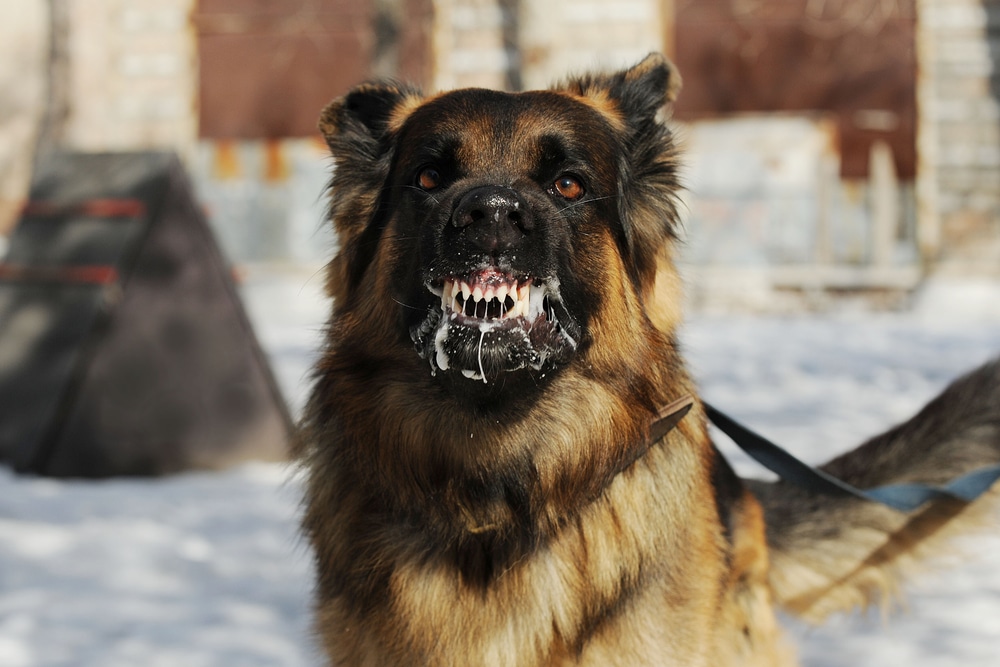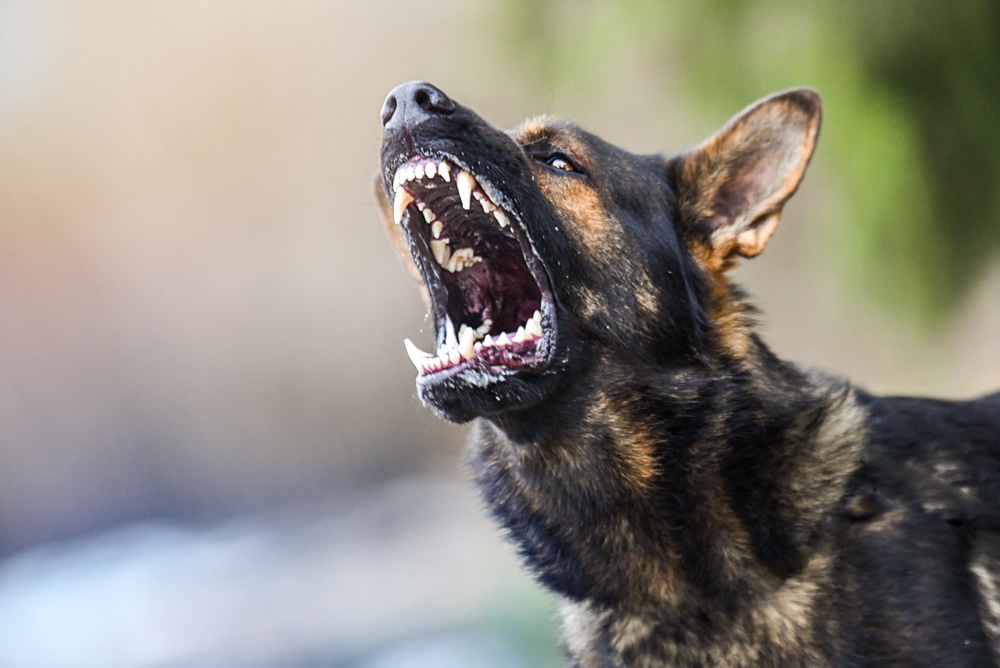There is an unsupervised kid playing near a dog, moving its toys between the dog’s front paws. The kid starts to lean forward to put a toy on the pet’s belly. Bang, “out of nowhere” the dog bites the kid and all of a sudden everyone starts panicking.“ But Toby (the dog) never did such a thing, he is an angel.” It happens that Toby probably showed several signs of discomfort before coming to that last stage of aggressiveness (biting). It’s also likely people could’ve prevented the situation if someone had just recognized the signs. So, come with me and let me show you the signs a dog is angry or aggressive.
The main signs a dog is angry or aggressive are stiffening up, growling, snapping, and biting, but there is a long progression until it comes to this that goes through yawning, licking the nose, turning the body away, walking away, ears back, and tail tucked under (between the legs).
Table of Contents
- What Makes A Dog Become Angry Or Aggressive?
- What Signs Does A Dog Show When It’s Angry Or Aggressive?
- Is It Common For A Dog To Become Angry Or Aggressive?
- What Should I Do If My Dog Becomes Angry Or Aggressive?
- How Can I Avoid An Attack From An Angry Or Aggressive Dog?
- Conclusion: Signs A Dog Is Angry Or Aggressive
What Makes A Dog Become Angry Or Aggressive?
Usually, a dog is not naturally aggressive. Of course, there are breeds that are more reserved and require caution when interacting with other dogs, kids, or strangers. Generally, though, animals avoid conflict unless they think it’s the only way out. That said, there are several reasons a dog can become angry or aggressive.
The first thing you need to rule out is a health issue. This is because an animal in pain or with neurological conditions may present anger. Other than that, aggressiveness basically appears as a response to stress or a threat. So, a fearful or anxious dog, naturally or due to trauma, for example, can easily appeal to aggression to protect itself while a possessive or dominant dog may attack because you’re stepping into its territory or because you got too close to its belongings.
If the anger or aggression becomes frequent, there’s one important thing to do. Whatever the cause (health issue, fear, anxiety, dominance, possessiveness), you have to observe the conditions in which your dog is showing aggressiveness and what signs it is presenting before attacking you or somebody else. This increases the chance of solving the problem and helps to avoid more serious accidents.
What Signs Does A Dog Show When It’s Angry Or Aggressive?

As we’ve seen, dogs are not naturally aggressive beings, so they are going to show escalating signs before an attack (they also show signs when they’re sad too).
All these steps are part of what we call The Ladder of Aggression, by Dr. Kendal Shepherd. It’s important to highlight that if a dog is blocked from doing a step, such as walking away (which happens a lot when a dog is on a leash), or is facing deep and heavy stress, it may progress more quickly up the ladder or even skip some steps.
Yawning, Blinking, And Nose Licking
It is not rare to see a dog opening its mouth several times to yawn and licking its nose frequently. People may think the dog is tired or acting randomly. But those are the first signs a dog is responding to stress or a threat and showing it’s uncomfortable.
Turning Head Away
If the first sign is ignored and the stressful and threatening stimulus continues, the next step the dog turning its head away from it. It can be from another animal, from a kid, or from anything else they are trying to escape from.
Turning Body Away, Sitting, And Pawing
If people didn’t notice the previous signs, the dog proceeds to turn its whole body away. It may even sit and paw in the direction of the undesirable stimulus. It is literally trying to put the problem away.
Walking Away
If none of the steps above work, the next step is to literally try to walk away from the issue. This way, the dog removes itself from the situation.
Creeping, Ears Back
If walking away fails, the dog will evolve to creeping. This is when they move (sometimes crawl) really slowly, carefully, and tensely. This is also often with the white part of the eye visible and putting its ears back. It is trying to tell you that it’s highly worried about its surroundings and that it needs some space.
Crouched With Its Tail Tucked Under
In this next step, the dog will try to show you that it is cautious about what is going on, but it is not a threat. It does this so that whatever it thinks is threatening it doesn’t need to keep doing so. Crouched with its tail between its legs is a sign of submission. It shows that the dog is trying to calm the situation down by making itself seem smaller and harmless.
Lying Down, Exposed Belly
Lying down with the belly exposed is another sign of submission. The dog is kind of saying that it surrenders. It’s also saying that you, or whatever the source of stress is, don’t have to keep pressuring it. Keep in mind this position is not the same as a relaxed exposed belly position to get belly rubs. This is more of a tense posture, and the pet often looks frozen.
Stiffening Up, Stare
After the dog tries several appeasement gestures (a kind of body language dogs use to show people and other animals that they don’t want to fight and that they are submissive) and they fail, it will proceed to a more alert, serious position. When the animal assumes a stiff posture and keeps staring, it is more than ready to continue to more serious steps if the threat is not removed.
Growl
Growling is a clear sign the dog wants what it perceives as a problem far away from where it is. It is obviously uncomfortable and asking for space.
Snap
Snapping (an abrupt movement of the dog’s head with a sudden closing of the teeth – almost like turning fast in the stress stimulus direction, intending to bite but biting the air instead) is the last step before biting. It is a serious warning. But the pet is still trying to sort the situation out before taking more drastic measures.
Bite
If none of the above worked, the dog will use its last resource to get rid of the problem: biting.
Is It Common For A Dog To Become Angry Or Aggressive?
I think the best way to put this answer is that it is not common for a dog to become angry or aggressive without a reason. If people respect the space and signs of the animal, and it is living well, it is rarely going to present with anger or aggressiveness.
But if the signs are constantly being ignored, and the dog realizes that the only way people listen to its discomfort is through growling, snapping, and biting, those are the resources it is going to choose to end unpleasant situations. Besides, dogs nowadays are often deprived of appropriate socialization, and they literally don’t learn how to interact with people outside the family and other animals, which can make them more prone to inadequate responses such as anger and aggressiveness.
What Should I Do If My Dog Becomes Angry Or Aggressive?
If you realize your dog has been showing signs of anger and aggression, it is important to identify when it started and what triggers this response. And, of course, before assuming it is “just” a behavior problem that came “out of nowhere” you need to take your friend to a veterinarian so it can rule out health issues such as pain and neurological diseases.
Once you find out your dog is healthy and that the aggressiveness is just behavioral, it is time to call a dog trainer or a veterinary behavior specialist. Solving the problem is way more difficult than just identifying the problem and recognizing some signs because the true cause can be multifactorial. And since it is dangerous to deal with aggressiveness, as a bite can result in some serious damage, the best you can do is to count on professional help.
How Can I Avoid An Attack From An Angry Or Aggressive Dog?
If you are calmly walking down a street and suddenly catch an eye on a loose hostile dog running towards you, there is not much to be done except try to find a place to hide or to climb. Now, if you are just worried about a dog you just met and are wondering if it’s safe to approach, you can avoid an attack by simply paying attention and observing the signs previously described.
If the dog is all about happiness, is wagging its tail, and has a relaxed posture leaning toward you, go for it! But if the dog seems tense and uncomfortable and tries to turn away every time you get closer, just give it some space and time. This way will be safer for both of you, and the contact will occur more naturally (if the dog eventually permits it).
Conclusion: Signs A Dog Is Angry Or Aggressive
To conclude, there are a lot of signs dogs use to show us they can act aggressively. The most obvious signs are stiffening up, growling, snapping, and biting, so we should avoid dogs that are showing these signs. But there are more subtle signals that are shown previously to those, such as yawning, licking the nose, turning the body away, walking away, ears back, and tail tucked under. If observed and respected, this can prevent accidents from happening.
So, did you know any of these signs beforehand? Have you ever had to deal with cases of anger or aggressiveness from a dog? Talk to us in the comments below!
